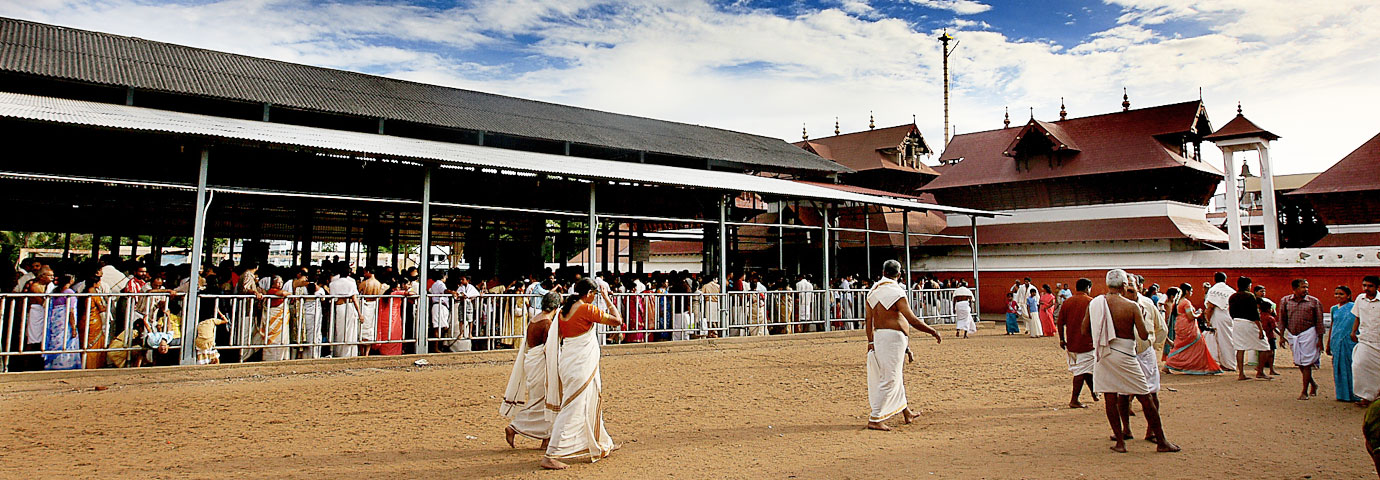Guruvayur, aptly called the Dwarka of the South, is one of the most significant pilgrimage centers in India. The idol of the famous Sri Krishna Temple here is said to have been worshipped by Lord Brahma himself. Everyday, endless waves of men, women and children pour in for darshan (audience) of Lord Guruvayur (Lord Krishna). Besides pilgrims and tourists, brides and grooms with hundreds of guests flock here daily to get their weddings solemnized.
The Guruvayur Temple is unique, as it is not built in the typical South Indian style of temple architecture. For example, its architecture is not massive or grand but simple in keeping with the style of Kerala houses. Its four gateways lead to the main gopuram (where the idol is installed), protected by a slopping terracotta roof made of Mangalore tiles. Again, in true Kerala style, the temple owns 36 mighty elephants that live at Punnathur Fort, 4 km north of the temple.
History
According to the Narada Purana, Brahma Himself was installed here. Serpents are mythically related to the famous Guruvayur temple. There is the myth that at the end of the Dwapara Yuga, the heir of the Pandavas, Parikshit, died bitten by Takshaka, the king of serpent. It was because of a curse by the son of a sage. Parakshit's son, Janamejaya, vowed to take revenge and started a sarpa yagna (snake sacrifice). Fearful of his certain death, Takshaka pleaded with Indra to save him. Indra sent Brihaspati, who requested Janamejaya to stop his yagna and Janamejaya yielded. However, he was soon afflicted by a virulent form of leprosy. Then sage Athreya asked him to take refuge in the temple of Guruvayur and worship Lord Krishna.
It is believed that King Sutapas and his wife, being childless, worshipped Lord Brahma who handed them the idol now installed at Guruvayur to worship. Eventually, Lord Vishnu appeared in His entire splendor and promised to be born as their child.
Lord Krishna was born as their son. After He left the earth for his heavenly abode, the holy port city of Dwarka was submerged. Guru, the preceptor of the gods and his disciple, Vayu, God of Winds, saved the idol. After a long quest for an appropriate site, they entered Kerala and met Parasurama, the legendary creator of Kerala. He led them to a beautiful lake full of lotuses, the present tank, Rudratirtha, beside which Shiva and Parvati waited to welcome them. The idol was duly installed by all of them. The temple and the place came to be known as Guruvayur, a reverential and semantic reference to the sponsors, Guru and Vayu.
Tourists Attractions
Kaladi is an important pilgrimage center since it was the birthplace of Sri Adi Shankaracharya, one of India's foremost philosopher-saints. He preached the monistic or advaita philosophy. He played a major role in saving the Hindu religion from the ritualistic and superstitious state to which it had degenerated.
Sri Shankaracharya's life has been marked by several miraculous exploits. He is said to have diverted the course of the River Periyar, which was 1½ km away from his house so that his aged mother could have her daily bath in the river without having to walk the distance. Even today, one can see an uncharacteristic turn in the river towards the Sringeri Math believed to be the site of Shankara's house. The shrine is situated on the right bank of the river and is a large partly open structure. There are two major shrines: one is dedicated to Sri Shankar acharya and the other to Goddess Saradamba, guardian deity of Sringeri.
The name Thrissur is derived from Tiru-Shiva-Perur meaning 'the town with the name of Lord Shiva'. The reigning deity, Lord Shiva, resides in the Vadakkunath Kshetram Temple, on a hillock right in the center of the city.
Punnathur Kotta, 4 km away, is an ancient fort that houses 40 elephants.
Chavakkad, 3 km away, has a pleasant beach and mausoleum of Haridross Kuttee, lieutenant of Haider Ali of Mysore.
Palayur, a kilometer away from Chavakkad, is the site of an ancient church believed to have been found by St. Thomas, the apostle.
Fairs & Festivals
The famous Pooram Festival (April/May) is celebrated at the Vaddakkunnath Temple. There are nightlong fireworks and a magnificent elephant procession. Shivratri (in March/April) is also celebrated with great fanfare. During Onam, the harvest festival (August/September), the entire state wears a festive look.
How To Reach
By Air - The nearest airport is Kochi, 90 km away.
By Rail - Thrissur, just 29 km away, is the nearest railway station.
By Road - Several state-owned and private buses as well as taxis regularly ply between Thrissur and Guruvayur. Bus connections are also available to all the important towns of Kerala as well as neighboring Karnataka and Tamil Nadu.


